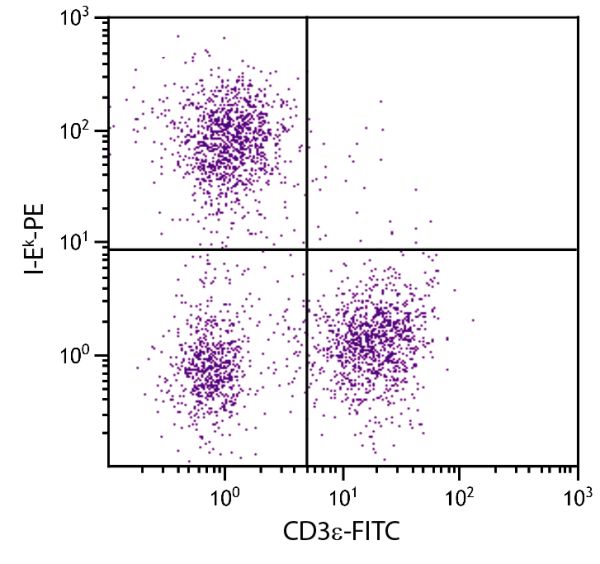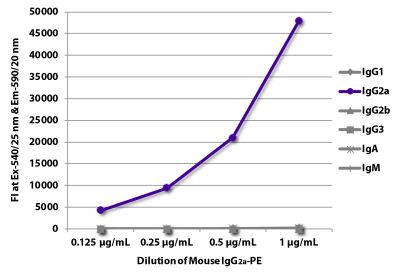Mouse Anti-Mouse I-Ek-PE (14-4-4S)
Cat. No.:
1897-09
PE Anti-Mouse I-Ek antibody for use in flow cytometry assays.
$189.00


| Clone | 14-4-4S |
|---|---|
| Isotype | Mouse (C3H.SW) IgG2aκ |
| Isotype Control | Mouse IgG2a-PE (HOPC-1) |
| Specificity | Mouse I-Ek/Rat RT1D |
| Alternative Names | MHC Class II |
| Description | The monoclonal antibody 14-4-4S reacts with the I-Ek class II alloantigen on cells from mice of the H-2d, H-2p, and H-2r haplotypes. Cells from mice of the H-2b, H-2f, H-2q, and H-2s haplotypes do not express I-E antigen. The antibody has been reported to cross-react with the rat MHC class II alloantigen RT1D. |
| Immunogen | C3H mouse skin graft and splenocytes |
| Conjugate | PE (R-phycoerythrin) |
| Buffer Formulation | Phosphate buffered saline containing < 0.1% sodium azide and a stabilizer |
| Clonality | Monoclonal |
| Concentration | 0.1 mg/mL |
| Volume | 1.0 mL |
| Recommended Storage | 2-8°C; Avoid exposure to light; Do not freeze |
| Applications |
Flow Cytometry – Quality tested 8,9 Immunohistochemistry-Frozen Sections – Reported in literature 7 Immunocytochemistry – Reported in literature 6 Immunoprecipitation – Reported in literature 2,3 Complement Mediated Cell Depletion – Reported in literature 1 Activation – Reported in literature 4 Blocking – Reported in literature 5 |
| RRID Number | AB_2795456 |
| Gene ID |
14969 (Mouse) |
| Gene ID Symbol |
H2-Eb1 (Mouse) |
| Gene ID Aliases | Eb; Ia4; H2Eb; Ia-4; H-2Eb |
| UniProt ID |
P18469 (Mouse) |
| UniProt Name |
HB2J_MOUSE (Mouse) |
Documentation
Certificate of Analysis Lookup
Enter the Catalog Number and Lot Number for the Certificate of Analysis you wish to view
- 1. Ozato K, Mayer N, Sachs DH. Hybridoma cell lines secreting monoclonal antibodies to mouse H-2 and Ia antigens. J Immunol. 1980;124:533-40. (Immunogen, CMDC)
- 2. Neiß U, Reske K. Non-coordinate synthesis of MHC class II proteins and invariant chains by epidermal Langerhans cells derived from short-term in vitro culture. Int Immunol. 1994;6:61-71. (IP, Rat RT1D Reactivity)
- 3. Bhattacharya A, Dorf ME, Springer TA. A shared alloantigenic determinant on Ia antigens encoded by the I-A and I-E subregions: evidence for I region gene duplication. J Immunol. 1981;127:2488-95. (IP)
- 4. Bishop GA, Haughton G. Induced differentiation of a transformed clone of Ly-1+ B cells by clonal T cells and antigen. Proc Natl Acad Sci USA. 1986;83:7410-4. (Activ)
- 5. Roy M, Aruffo A, Ledbetter J, Linsley P, Kehry M, Noelle R. Studies on the interdependence of gp39 and B7 expression and function during antigen-specific immune responses. Eur J Immunol. 1995;25:596-603. (Block)
- 6. Lenz A, Heufler C, Rammensee H, Glassl H, Koch F, Romani N, et al. Murine epidermal Langerhans cells express significant amounts of class I major histocompatibility complex antigens. Proc Natl Acad Sci USA. 1989;86:7527-31. (ICC)
- 7. Farr A, DeRoos PC, Eastman S, Rudensky AY. Differential expression of CLIP:MHC class II and conventional endogenous peptide:MHC class II complexes by thymic epithelial cells and peripheral antigen-presenting cells. Eur J Immunol. 1996;26:3185-93. (IHC-FS)
- 8. Rinderknecht CH, Roh S, Pashine A, Belmares MP, Patil NS, Lu N, et al. DM influences the abundance of major histocompatibility complex class II alleles with low affinity for class II-associated invariant chain peptides via multiple mechanisms. Immunology. 2010;131:18-32. (FC)
- 9. Rinderknecht CH, Lu N, Crespo O, Truong P, Hou T, Wang N, et al. I-Ag7 is subject to post-translational chaperoning by CLIP. Int Immunol. 2010;22:705-16. (FC)
See More




